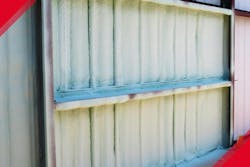Spray and board foam plastic insulation: A primer for metal building suppliers
Over the last few years, I’ve been asked many questions about the use of spray and board foam plastic insulation in metal buildings. There is little doubt that the use of foam plastic insulation in metal building exterior roof and wall assemblies is on the rise. This has been driven by several factors, including:
- Increased minimum performance thresholds in the newer building energy efficiency codes
- Decreased rated capacity of fiberglass systems in the newer building energy efficiency codes
- Lower cost of foam plastic insulation created by increasing competition
- Increased popularity and affordability of spray foam systems
However, simply substituting R-value-for-R-value of insulation systems cannot be done. Many complications to the metal building envelope design are introduced when foam plastic insulation is used. Examples of these include:
- Special fire protection requirements
- Implications to structural design of secondary framing
- Installation challenges, particularly with through-fastened roofs
- Difficulty in evaluating in-place performance levels (i.e., U-factor determination)
- Thermal expansion and contraction concerns (particularly with spray-foam)
This is just to name a few. The first point is of primary consideration and will be the subject of the remainder of this blog. Structural issues will be addressed in a future entry. But before we get into this, it’s important to remember that occupant safety is the absolute highest priority consideration in building design. While thermal performance is important, nothing can compromise occupant safety and fire protection sits atop the list with structural capacity as a close second.
About the Author

Bob Zabcik
Bob Zabcik is NCI’s Director of Research and Development. He is a LEED Accredited Professional and a Registered Professional Engineer with more than 20 years of experience. He serves on several professional committees such as the MBMA Energy Committee and Sustainability Committee as well as several task groups of those committees. He is also on the Board of the Cool Metal Roofing Coalition and serves as the Director of their technical committee.
